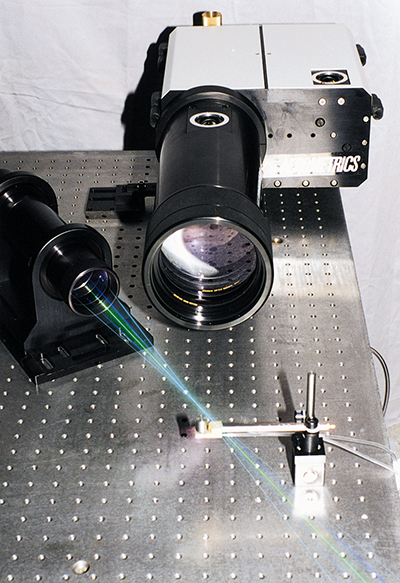Somewhere in the Rainbow
Spray combustion processes can be studied, thanks to a device built to measure fuel droplet size distributions by bathing them in laser light.
Aerometrics, Incorporated of Sunnyvale, California, first developed, through a Small Business Innovation Research (SBIR) contract with Lewis Research Center, a particle analyzer using a Phase Doppler technique. This laser instrument provided a non-disruptive method of determining particle size, number density, flow velocity, diameter versus velocity, trajectory, turbulence intensity, and more.
A follow-on NASA SBIR contract with Aerometrics has now built upon that earlier product. The new technology can be integrated with the company's Phase Doppler Particle Analyzer (PDPA) systems, or used independently.
This latest device from Aerometrics--a rainbow refractometer--is keyed to measuring the refractive index of a droplet by monitoring, in a non-intrusive manner, the main rainbow location with a Charge Coupled Device (CCD) linear array. Refraction is the bending of a ray of light at the boundary of two mediums of dissimilar nature. When droplets are illuminated by laser light, they give rise to a characteristic rainbow pattern in the backscatter direction. This pattern can be recorded using a CCD line camera and the data processed to extract the refractive index information, which is a function of droplet temperature, for a given droplet composition. The refractive index of particles as small as 20 microns in diameter can be measured. For particles less than 150 microns, the Doppler particle analyzer and the refraction instrument can be used in conjunction.
Some applications of the technology include:
- Spray Flame Characterization Fuel droplet size and velocity in complex spray flames can be measured. No other instrument is capable of measuring individual fuel droplet temperatures in a spray flame. By measuring droplet size, velocity, and temperature, data can be used to validate advanced theoretical spray combustion models that are routinely used in the design of fuel efficient combustors.
- Droplet Combustion Studies in Microgravity A compact diode laser-based rainbow refracto- meter system is under development by Aerometrics. This instrument can be used for obtaining the temporal evolution of fuel droplet size, internal temperature profile/gradient, and droplet regression rate in single droplet combustion experiments. Those tests are to be carried out aboard NASA's microgravity producing aircraft, created by parabolic flight trajectories of the plane.
- Rocket Engine Mixing Studies In liquid rocket engine injectors using more than one liquid propellant, adequate and uniform mixing of the fuel with an oxidizer is essential if efficient combustion is to be realized. Tasking the combined Phase Doppler/rainbow refraction device provides a useful means for studying liquid-liquid mixing even in a reactive environ- ment. Individual droplets within propellant sprays can be sorted out based on the measured droplet refractive index. This information can subsequently be used to compute the spatial and temporal variations of the liquid propellant mixture ratio.
Devices built by Aerometrics are expanding the boundaries of particle diagnostics technology. Not only research oriented work by the government, industry, and educational institutions can benefit by using the laser equipment.
"Everyone benefits from research geared toward furthering the quality of life," says marketing specialist for Aerometrics, Kristi Altier. "Our rainbow refraction instrument will make important contributions toward important chemical and combustion research," she says.

Aerometrics' instrument can inspect, via laser light, individual droplets of fuel for combustion research.













